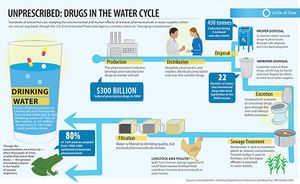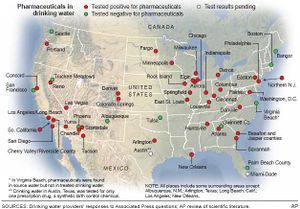Template:Pharmaceuticals in drinking water
Pharmaceuticals in drinking water
Ecological research has received particular attention because exposure risks for aquatic life have been considered to be much greater than those for humans.[3] Nonetheless, a key research issue concerns the possible health risks from exposure to very low doses of the myriad chemicals found in PPCPs. Because PPCPs occur in the environment at low concentrations, their effects may be subtle. Among other research gaps, EPA has identified a need to develop tests that can detect more subtle health effects.
The agency is also conducting a study to determine the amount of PPCPs that are discharged to wastewater treatment plants from various sources. As part of this study, EPA is evaluating how hospitals and other institutions dispose of unused medications.[4] Other research projects address the development of analytical methods to determine the source and fate of PPCPs in the environment.
As noted above, EPA proposed its third list of unregulated contaminants being considered for regulation in February 2008. This Contaminant Candidate List 3 (CCL 3) contains 104 contaminants, none of which are pharmaceuticals. Following recent reports of the detection of pharmaceuticals and commonly used over-the-counter drugs in the drinking water supplies of 24 large community water systems, EPA has asked its Science Advisory Board (SAB) and stakeholders to evaluate and comment on the contaminant candidate screening and selection process to determine whether the process requires revision.[5]Because of ecological concerns, as well as human health concerns, regulating contaminants in drinking water represents only part of the response to this multi-faceted problem. Recognizing that people and animals will continue to take and use pharmaceutical products, water suppliers and other stakeholders consider changes at wastewater treatment plants to be a key part of the solution.The Association of Metropolitan Water Agencies (AMWA), which represents the largest publicly owned water systems, has made several recommendations to address this emerging drinking water issue. Among these recommendations, the AMWA strongly encouraged EPA to make research on treatment technologies a high priority, and urged water utilities to inform consumers of efforts to monitor and remove pharmaceuticals from water sources. AMWA also called for EPA and the Food and Drug Administration (FDA) to determine whether the presence of trace amounts of pharmaceuticals results in short-term or long-term effects on health and the environment, recommended that the federal government take the lead in developing a national program for disposing of unused prescriptions, and called for animal feeding operations to reduce their contributions of antibiotics and steroids into water supplies.[6]
Legislation in the United States Congress
Several bills addressing this issue have been introduced in the United States Congress, including two that have passed the House: H.R. 1145 (H.Rept. 111-76) would call for research on prevention and removal of contaminants of emerging concern, including PPCPs, in water resources; and H.R. 1262 (H.Rept. 111-26) would direct EPA to conduct a study on the presence of PPCPs in the nation’s waters. Additionally, the House Appropriations Committee report for EPA’s FY2010 appropriations (H.R. 2996, H.Rept. 111-180) encourages EPA to develop a plan to synthesize available research on contaminants of emerging concern and to apply a systematic approach to addressing the problem of such contaminants in water supplies. The House report further directs EPA to publish a list of at least 100 chemicals for screening in the Endocrine Disruptor Screening Program that includes drinking water contaminants such as PPCPs. H.R. 276 was introduced in January 2009 to require the EPA Administrator to convene a task force to develop recommendations for the proper disposal of unused pharmaceuticals to protect water sources.
References
| Disclaimer: This article is taken wholly from, or contains information that was originally published by, the Congressional Research Service. Topic editors and authors for the Encyclopedia of Earth may have edited its content or added new information. The use of information from the Congressional Research Service should not be construed as support for or endorsement by that organization for any new information added by EoE personnel, or for any editing of the original content. |
Note: The first version of this article was drawn from RL34201 Safe Drinking Water Act: Selected Regulatory and Legislative Issues by Mary Tiemann, Congressional Research Service on September 2, 2009.

